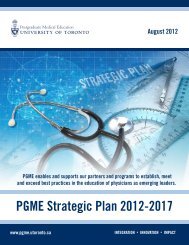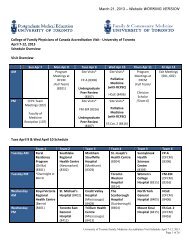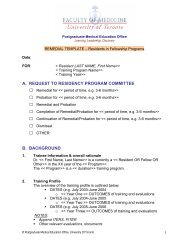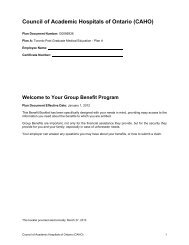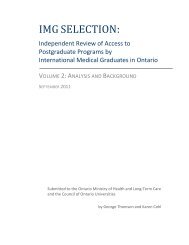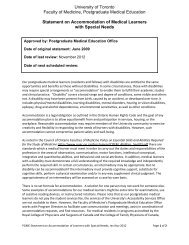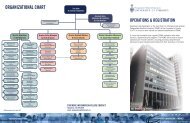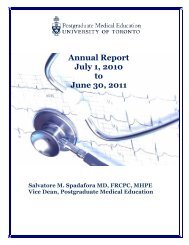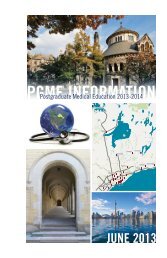Postgraduate Medical Education Information Booklet 2012-2013
Postgraduate Medical Education Information Booklet 2012-2013
Postgraduate Medical Education Information Booklet 2012-2013
You also want an ePaper? Increase the reach of your titles
YUMPU automatically turns print PDFs into web optimized ePapers that Google loves.
University of Toronto Faculty of Medicine PGME <strong>2012</strong>-<strong>2013</strong><br />
Immunization:<br />
Blood and Body Fluid Exposure Policy for University<br />
of Toronto <strong>Postgraduate</strong> <strong>Medical</strong> Trainees<br />
Each of the hospitals fully or partially affiliated with the University of<br />
Toronto Faculty of Medicine have policies and procedures to follow when<br />
sustaining a percutaneous or mucous membrane exposure to blood or<br />
body fluids. In order to ensure safety of themselves and their colleagues,<br />
Program Directors must:<br />
a) ensure that, at the beginning of the rotation/assignment to a new<br />
site, trainees know the initial contact point for reporting of “sharps”<br />
injuries at the site, in order to access intervention (Post-Exposure<br />
Prophylaxis - PEP) if required<br />
b) include blood and body fluid exposure management protocol in the<br />
program’s academic curriculum sessions.<br />
Program Directors must further ensure that residents in training outside<br />
Toronto’s affiliated teaching hospitals (clinics, elective rotations) are<br />
provided with blood and body fluid exposure policies and procedures<br />
specific to their training site.<br />
The Toronto PGME Office will maintain records of trainees’ HBV immunity<br />
as part of mandatory immunization records, and will share this<br />
information with Hospital Occupational Health or Delegate as required.<br />
(see PGME Office Procedural Memorandum on Responsibility of Notice to<br />
Programs and Hospitals for <strong>Postgraduate</strong> <strong>Medical</strong> Trainees who are<br />
Hepatitis B Positive, March 31, 2000)<br />
Procedural Guidelines for Occupational Exposure to Blood<br />
and/or Body Fluids:<br />
1. Know your immune status to the Hepatitis B Virus (HBV).<br />
Responsibility: <strong>Medical</strong> Trainee<br />
2. Apply first aid: allow the wound to bleed freely. Wash wound and skin<br />
sites which have been in contact with blood or body fluids with soap and<br />
water; mucous membranes should be flushed with water. A tetanus shot<br />
may be required if the injury is deep and significant time has elapsed<br />
since the last tetanus booster.<br />
Responsibility: <strong>Medical</strong> Trainee<br />
60



